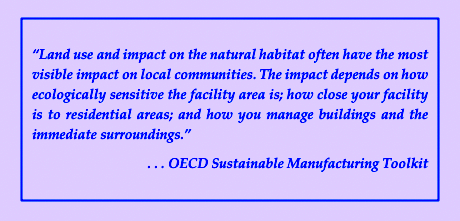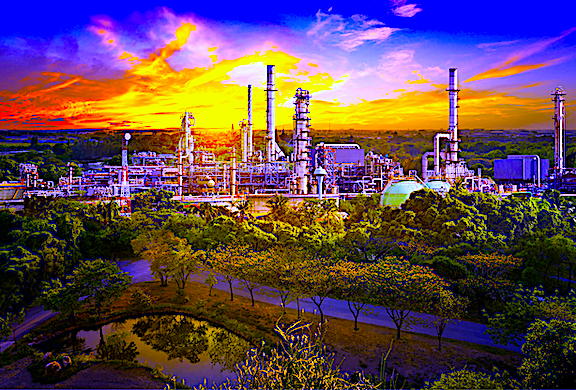Industrial plants and facilities are natural drivers for economic growth and development. For the most part, this is great news. Industrial facilities create good, high paying jobs for the people in the community, typically leading to development and generally increasing prosperity for the communities in which the industrial facilities reside. In some instances, however, incompatible and unsustainable development can pour rain on the good-news parade. Creating a compatible-use land buffer around your plant or facility can significantly reduce risks associated with incompatible development.
The Organization for Economic Cooperation and Development (OECD, oecd.org) offers a “Sustainable Manufacturing Toolkit” that defines 18 important key performance indicators (KPIs) for sustainable manufacturing. (I addressed these KPIs in my August 8, 2020, article for The RAM Review.) One of those KPIs, “Proportion of Natural Land,” is simply calculated as the natural land area divided by the total land under management. The OECD’s toolkit sums up, quite concisely, the reasons why natural land surrounding the facility is so important (see below).

RISKS
Several potential negative consequences introduce risk when people get too close to industrial facilities, or if the development required to support their presence adversely alters the landscape. Often, these risks can be mitigated by creating a compatible-use land buffer. These risks include:
♦ Noise and light pollution. Most industrial plants and facilities operate 24 hours a day, seven days a week. It’s not uncommon for truck traffic to be entering and exiting these sites around the clock. The noise and light pollution associated with such activities can elicit complaints from the surrounding community. A compatible use land buffer puts space between the operation and the people who are affected and might complain.
♦ Potentially dangerous emissions into the atmosphere. More noxious than noise and light pollution, emission from an industrial facility can be unpleasant, harmful to the health of residents, explosive or in some cases, highly toxic. As with noise and light pollution, a compatible-use land buffer puts space between potentially dangerous releases and the people who they might affect.
♦ Potentially dangerous effluent into the hydrosphere. Intentional or unintentional releases into the watershed can adversely affect drinking-water quality in communities near industrial facilities. For example, in the United States, the petrochemical belt along the Gulf of Mexico is often referred to as “Cancer Alley” due to chemical releases, especially benzene.
♦ Potentially dangerous deposits in the lithosphere. Deposits in the lithosphere, especially mine tailings, can leach into the watershed and create a great deal of harm. For example, lead, zinc, cadmium, and manganese mining operations in the Tri-State Mining District of Oklahoma (often referred to as “Tar Creek”) polluted soils and watersheds in the area so severely that entire communities of people were forced to vacate.
BENEFITS
In addition to putting space between industrial facilities to reduce the impacts of light and noise pollution and risks associated with emissions and effluent to the atmosphere, hydrosphere and lithosphere, compatible-use land buffers provide additional important ecosystem value and services that reduce risk to the industrial facility and its various stakeholders. Nowhere are the benefits of a compatible-use land buffer more important than the many process-plant operations located in U.S. coastal regions around the Gulf of Mexico. These benefits include::
♦ Provides important wetlands and riparian buffers. Wetlands provide important ecosystem functions by serving as filters for the environment. e.g., removing harmful contaminated effluent coming from industrial facilities, leachate from landfills, and other harmful releases. Riparian buffers, e.g., strips of land planted with flora, provide these filter services for the ecosystem surrounding industrial facilities, providing important protections for people who reside near such operations. However, an alarming percentage of the coastal and freshwater wetlands and open spaces that provide riparian services have been lost to development. This is particularly evident in the petrochemical strip along the U.S. Gulf Coast. Between 2004 and 2009 alone, there was a loss of more than 90,000 acres of saltwater wetland and more than 160,000 acres of freshwater wetlands.
♦ Protection against storm surge along coastal regions. For logistical purposes, industrial facilities are often located in coastal areas to support the movement of raw materials and finished goods. These coastal areas are highly susceptible to hurricanes and tropical storms. During a hurricane, wind velocity gets the lion’s share of attention in the news, yet it’s water from storm surge that exacts most of the damage. The damage from water is partly due to the sheer volume, but it’s the velocity of the water, an incompressible fluid, that’s dangerous. The plant life in wetlands and riparian areas covered with trees and other flora introduce resistance to flow, slowing down the velocity of the storm surge and mitigating its damage potential.
There are many other good reasons to incorporate natural land buffers to separate industrial facilities from people in surrounding communities and the ecosystem at large. Land buffers can be created by acquiring property and placing a restricted-use easement on it. Alternatively, and often much less costly, the buffer can be established through the acquisition of a perpetual conservation-easement agreement with a willing landowner who is compensated for agreeing to terms that restrict incompatible development. Still, in other instances, wetland and stream restoration or creation can produce marketable mitigation credits that could be sold as compensation for environmental impacts elsewhere within the watershed.
BOTTOM LINE
Incompatible land use around an industrial facility creates real operational risks for the plant and environmental and social risks for the stakeholders who live near the facility and depend upon it for jobs and other economic services. That’s why the OECD included “Proportion of Natural Land” as one of the KPIs in the organization’s “Sustainable Manufacturing Toolkit.”
The question is, has your organization included the risks discussed here in its operational risk-assessment and management plan? If not, take a look at the “OECD Sustainable Manufacturing Toolkit,” a free downloadable document (see link below). And don’t hesitate to reach out to me at dtroyer@theramreview.com with questions or to obtain further information about how a compatible-use land buffer can benefit your objectives for sustainable manufacturing.TRR
And/Or
Click Here to Download the “OECD Sustainable Manufacturing Toolkit”
ABOUT THE AUTHOR
Drew Troyer has over 30 years of experience in the RAM arena. Currently a Principal with T.A. Cook Consultants, he was a Co-founder and former CEO of Noria Corporation. A trusted advisor to a global blue chip client base, this industry veteran has authored or co-authored more than 300 books, chapters, course books, articles, and technical papers and is popular keynote and technical speaker at conferences around the world. Drew is a Certified Reliability Engineer (CRE), Certified Maintenance & Reliability Professional (CMRP), holds B.S. and M.B.A. degrees. Drew, who also earned a Master’s degree in Environmental Sustainability from Harvard University, is very passionate about sustainable manufacturing. Contact him at 512-800-6031, or email dtroyer@theramreview.com.
Tags: reliability, availability, maintenance, RAM, environmental sustainability, compatible use buffers, sustainable manufacturing, energy efficiency, safety, climate change, Organization for Economic Cooperation and Development, OECD



